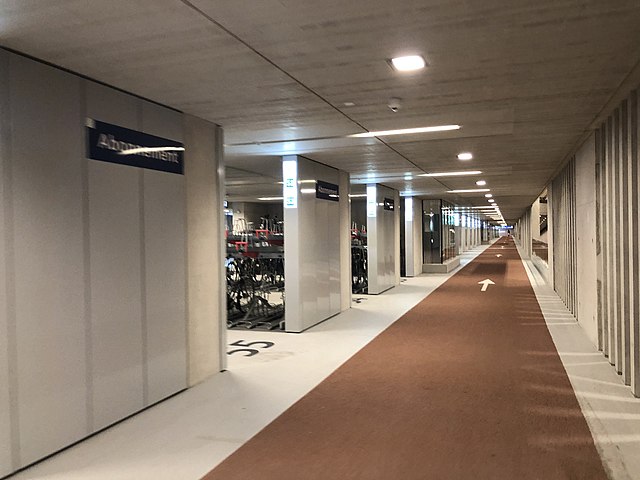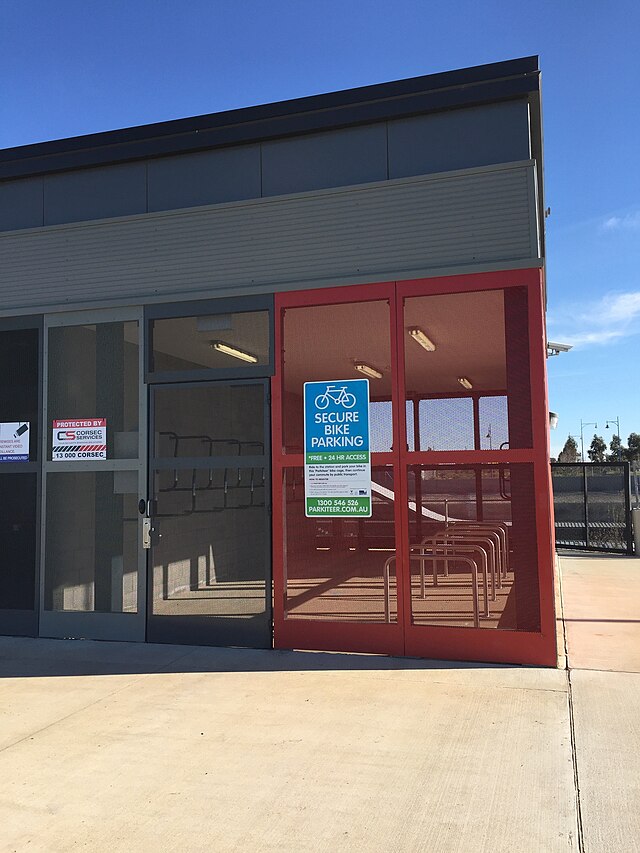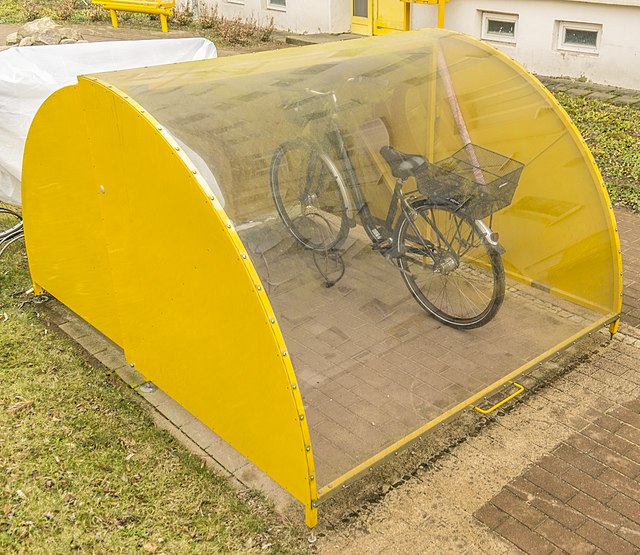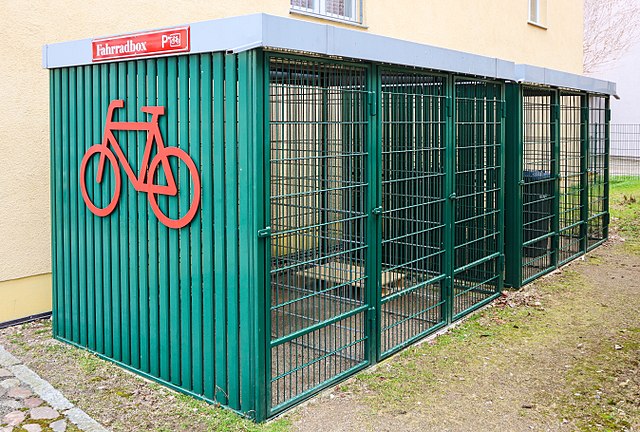Bicycle parking station
Building or structure for bicycle parking From Wikipedia, the free encyclopedia
A bicycle parking station, or bicycle garage, is a building or structure designed for use as a bicycle parking facility. Such a facility can be as simple as a lockable bike cage or shed or as complex as a purpose-built multi-level building: the common purpose is that they provide secure bicycle parking. Bicycle parking stations also go by names such as bike stations, bicycle centers and cycle centers, among many others.





Bicycle parking stations can offer additional facilities such as bicycle repairs, and customer facilities such as showers or lockers. Some are staffed while others are not. Some require users to join as members, while others are on a per-use basis or completely free of charge. Some are based at railway stations to facilitate "bike and ride" multi-modal transport, while others are situated at the end of the commute and as such are located in town or city centres, universities, and workplaces. Advanced bicycle parking station provide protection from weather, thieves and vandalism not only for the vehicle but also for the helmets and other personal belongings. In order to use less floor space, they store the vehicles vertically, either in a kind of towers or under the floor in shafts. It is important that the access time is short, even if several users want to store or transfer their bicycles at the same time.
Operation
Bicycle parking stations are often operated by local governments or municipalities or they can be private businesses run by bike shops or non-profit bicycle advocacy organizations. Some are fully automated.[3]
Types
There are several types of bicycle parking stations. Most bicycle parking stations are non-automatic, and the user usually leaves their bike at bicycle parking racks in the facility. These facility are usually sheltered or indoor, but unsheltered outdoor facilities also exist.
Automatic bike parking stations exist in many forms, such as underground silos using automated storage and retrieval system.[4]
Services
Bike stations may have several services connected to the facility, including on-site security or a gate or door secured by key or by proximity card access to prevent thefts. Customers may also be able to use showers or locker rooms and changing rooms. There may be on site bathrooms and drinking fountains as well as food and beverages available via vending machines.
There may also be information available, such as pamphlets/brochures for bicycle safety, maps and other literature ,e.g. about cycling routes or nearby points of interest. Some may even provide classes, e.g. bike maintenance or local area knowledge.
Bike services
Some bike stations (such as at many railway stations in the Netherlands) have staff who are able to carry out simple or complex repairs for a fee. This is useful for commuters who can leave their bike there in the morning and pick it up fully repaired at the end of the day when on the way home. Regardless of whether repairs are available at a station or not, the station may also provide parts and accessories for sale, an air pump, and bicycle rentals.
Pricing
The most common pricing scheme for bike stations are:
- a user pays service: the stations cost money to use, either through daily, weekly, monthly payments or through periodic memberships (though sometimes non-members can pay for daytime locker use).
- free-of-charge service: the bike stations are usually fully paid for by the local municipality, local regional government, or by the operating company (e.g. for bicycle parking stations located at railway stations)
- mixed system: some small charge may be required from the end-user (e.g. an administration charge) but the bulk of the operating costs are paid for by another entity.
Construction costs
- The bike station in Washington, D.C., opened in 2009 and cost 4 million US dollars[5] for 1,700 square feet (160 m2) of space and storage for 150 bicycles.
- The King George Square Cycle Centre in Brisbane, Queensland opened in June 2008 and cost 7 million Australian dollars.[6] It has 33 showers, 420 lockers, and parking for 420 bicycles in two-level racks.
- The bike station at Utrecht Railway Station in the Netherlands was completed in 2019 for around €30 million and holds 12,500 bicycles, making it the world's largest. It has three levels of double-decker bike racks, connected by gentle sloping ramps.[7]
- The RBWH Cycle Centre in Brisbane opened in November 2009[6] and cost A$8 million. It has 40 showers, more than 900 lockers, and parking for 750 bicycles.[8]
- The Parkiteer swipe card accessible bike cages of Victoria, Australia, which have at least 26 racks in them and cost approximately $AUD110,000 each.[9]
Bicycle parking stations around the world
Summarize
Perspective



The following is a list of selected bicycle parking stations located in several countries around the world, often at train stations.
- Australia
- Melbourne, Victoria - As of October 2024[update], there are more than 150 Parkiteer bicycle parking cages[10] spread across Melbourne's 222 suburban rail stations, including 2 at park-and-ride bus stations and 29 at V/Line regional rail stations across the state of Victoria. These cages are accessible via registered swipe card or NFC through a mobile app. Most have bike racks for 26 bicycles each, though some have capacity for up to 67 bicycles.[11][12] Parkiteer facilities at railway station precincts are provided in addition to casual open-air bicycle parking racks.
- Brisbane, Queensland: air conditioned facilities with showers, lockers, maintenance and dry cleaning services
- cycle2city, located at King George Square busway station in the CBD (also known as the King George Square Cycle Centre), with 420 places[13]
- RBWH Cycle Centre, located at the Royal Brisbane and Women's Hospital in Herston with 750 places[14]
- Europe
- Belgium
- Ghent, Gent-Sint-Pieters railway station, under construction: two stations to host 17,000 bicycle parking spots in total.[15]
- Germany
- Netherlands
- Amsterdam
- Arnhem Fietsenstalling Station with 4500 places.
- Delft
- Deventer Fietsenstalling Stationsplein with 3600 places.[23]
- Ede Fietsenstalling Station with around 5500 places.[24]
- Leeuwarden
- Fietsenstalling station with around 3000 places.
- Groningen
- Leiden Lorentz with 4800 places.
- Maastricht Fietsenstalling station with around 3000 places.[27]
- Nijmegen
- Rotterdam Centraal Station, with 5190 places.[29]
- The Hague Koningin Julianaplein with around 8000 places.[30]
- Tilburg
- Utrecht
- Zwolle Fietsenstalling Stationsplein with 5475 places.[37]
- Spain
- United Kingdom
- Greater Manchester - Transport for Greater Manchester has developed several Cycle Hubs.
- Cambridge - The new station development contains around 3000 places.[39]
- Belgium
- North America
- Bikestation : Long Beach, Covina, Claremont, Santa Barbara, Palo Alto, CA, Washington DC, and Seattle WA.
- Chicago, Illinois - The McDonald's Cycle Center in Millennium Park.
- St. Louis, Missouri - Located downtown at 10th & Locust.
- Vancouver, BC - Bike parkades are located at some SkyTrain and West Coast Express stations.[40]
- South America
- Mauá, a suburb southwest of São Paulo, Brazil at the Mauá railway station on Line 10 of the CPTM. video of the bike station on Streetfilms. This bicicletário (bike rack in Portuguese) is operated by ASCOBIKE, or Assoçiâo dos Condutores de Bicicletas.
See also
References
External links
Wikiwand - on
Seamless Wikipedia browsing. On steroids.
